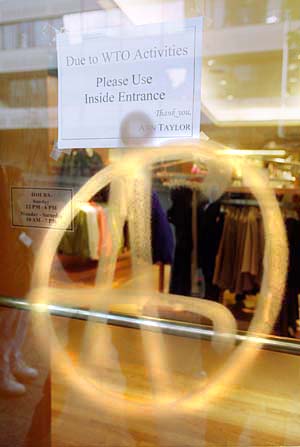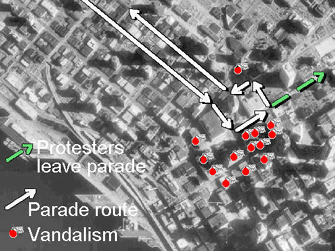
Black Blocs Run Amok
by Paul de Armond
 |
by Paul de Armond |
|
 While
the police were regrouping and preparing to force the Direct Action Network protesters to join the AFL-CIO parade, several groups took advantage of the lull in the battle. They've all been lumped together into a nameless anarchist horde, but the fact remains there were two distinct groups acting out different agendas, not one "organized" anarchist conspiracy as the myth would have it.
While
the police were regrouping and preparing to force the Direct Action Network protesters to join the AFL-CIO parade, several groups took advantage of the lull in the battle. They've all been lumped together into a nameless anarchist horde, but the fact remains there were two distinct groups acting out different agendas, not one "organized" anarchist conspiracy as the myth would have it.
The first of these groups were the so-called "Anarchists from Eugene," more correctly known as the "Black Bloc." The media's tag-line of "Anarchists from Eugene" is one of those lazy half-truths which sums up media coverage of the entire protest. The half-truth is that people from Eugene participated in the Black Bloc, the other unreported half of the truth is that people from Seattle and the surrounding region committed most of the vandalism and nearly all of the looting. The lie was that the Eugene faction in the Black Blocs -- which numbered perhaps 40 people at most -- were responsible for the violence in the streets and that the vastly larger number of anarchists -- several thousand, at least -- participating in the non-violent demonstrations endorsed or followed the violent tactics of vandalism and property destruction which the Black Blocs committed. The message which still hasn't penetrated the media is that the Black Blocs accomplished an international coup of "culture jamming" by selectively targeting a handful of posh retailers for broken windows. In committing this criminal vandalism, they conformed to pre-established media stereotypes of "violent anarchists" and effectively hijacked several weeks of coverage into a fantasyland which served their propaganda goals admirably. The primary target of the Black Blocs was not the WTO or the businesses whose windows were broken. The Black Blocs were in Seattle to radicalize the Direct Action Network protesters and discredit the AFL-CIO and their allies among the "mainstream" environmental groups. And that is precisely what they did -- with the significant assistance of the other wild card group, the out-of-control police who sought to escalate the violence. Speaking on an anarchist video, "RIP WTO N30", one masked Eugene anarchist explained targeting the non-violent protesters: "Hopefully, we can come out here and give them a shove in a little more radical direction. . . . I'm hoping that we can come out here and get crazy and fuck enough shit up that every city in the world knows that it can't host a WTO conference. And it better give control back to the poeple of their own lives or else that city is going to get torn to pieces. After the protests, the same anarchist appeared unmasked on 60 Minutes II. He explained the use of masks: "We want to pose a credible threat to the biggest, most powerful people in the world. And if that's the kind of work you want to dao and you want to do it over your whole life, you have to be able to keep doing your work without quickly being aprehended and being sent away to jail for a long time." It is worth noting that the police who were involved in unjustified use of force or outright criminal misconduct were also very concerned to protect the anonymity of the guilty parties.
|
|
At
approximately 1PM, the police temporarily stopped trying to push corridors through the protest area. The "Black Bloc" anarchists had entered into an understanding with the Direct Action Network that they would refrain from vandalism at least as long as the protests remained peaceful. This is another way of saying that they were loosely following the lead of the DAN organizers while targeting the protesters to take the brunt of the reaction to their attacks. How loosely is shown by the fact the Black Bloc arrived downtown armed with hammers, crowbars, spraypaint, M-80 firecrackers and paintbombs. Their goal was a "propaganda of the deed" centering around vandalizing chosen stores -- Nike, Starbucks, the Gap, Old Navy and others -- which they saw as fitting targets.
The Black Bloc was simply biding their time and waiting for an opportunity to vandalize these stores and then get away. They had been closely monitored by the police and FBI since the preceding day. Early Tuesday morning, the FBI had briefed Seattle Police on the Black Bloc's whereabouts and activities. The close observation of the Black Bloc included undercover FBI agents dressed to blend in with the anarchists, right down to wearing masks to hide their faces. Also present in the streets were members of the Army's Delta Force, a paramilitary counter-terrorist group, dressed in civilian clothes to blend in with the protesters. According to KIRO TV, the Black Bloc rampage started on 6th Avenue between Pine Street and Olive Way. Vandals smashed the windows of a Starbucks coffee shop in the middle of the block, then moved north towards Olive Way. Turning west on Olive Way, they attacked the SeaFirst bank, then turned south on 5th Avenue. Two or three stores along this block were vandalized. Emerging onto Pine Street, the Black Bloc turned again, moving west and attacking three or four more stores in the next two blocks. Reaching Third Avenue, the Black Bloc turned south and dispersed. The Seattle Times reported that the vandalism centered mainly along Pike Street, between Third and Sixth Avenue. A map showing the location of vandalized and looted stores published in the Times overlaps the route of the Black Bloc only at the beginning and end. The majority of the vandalism occurred around 4th and Pike, a corner that the Black Bloc avoided while being videotaped by KIRO TV. It is possible that the TV news crews missed the early stages of the vandalism and erroneously reported the vandalism as beginning later than was actually the case. The discrepancy between reports is partly due to the chaos which gripped the downtown, but is also due to the fact that large numbers of teenagers who were not part of the Black Bloc took advantage of the situation and likewise engaged in vandalism. It was this second group, estimated to number at least one hundred or more, who engaged in looting some of the broken store windows, as well as occupying the awning over the Nike store. In addition to the damage to commercial property, police cars and limousines were vandalized with spraypaint and by having their tires slashed. Jeff Boscole, an eyewitness who was on Sixth Avenue, described how the two groups could be distinguished by their dress and the different slogans which they spray-painted on buildings and windows. According to Boscole, the Black Bloc graffiti consisted of legible political slogans, while the "wilding teenagers" were "tagging" with illegible individualized symbols which were not slogans. The three of the "wilding teenagers" are clearly shown in two photographs published in the December 1, Seattle Times. One picture shows a lone teenager, standing on a deserted sidewalk and reaching through a broken window. Under one arm, he is holding a skateboard. The windows and front of the store are defaced with graffiti, some of which are anarchist slogans and others, particularly the one center-left which dominates the picture, are "tagging" signatures, the incomprehensible glyphs common throughout urban areas. The other photo shows two teenagers and the right foot of a third, as one breaks off the "T" in the Nike Town sign. None of the teenagers are masked and all three wear light-colored clothing.
|
|
 The
Black Bloc faction engaged in property destruction numbered no more than thirty to forty people, all dressed similarly in black. All were hooded or masked to prevent their identification. They moved a brisk pace, occasionally stopping in small groups to break windows or spray-paint anarchist and anti-corporate slogans. Early in the raid, they twice attacked KIRO TV news crews, spraying the camera lenses with paint to stop the crews from taking pictures. After these attacks, news crews withdrew half a block to avoid further attacks. The Black Bloc maintained cohesion and moved along their route in a determined manner, several times scuffling with the non-violent protesters from the Direct Action Network. A handful of plainclothes police and FBI shadowed the group, reporting their movements. Police made no effort to halt the vandalism, but in several instances Direct Action Network protesters stopped or interfered with members of the Black Bloc, while others chanted "no violence" to little avail. According to an independently produced video on the protests, the total number of windows broken was seventeen.
The
Black Bloc faction engaged in property destruction numbered no more than thirty to forty people, all dressed similarly in black. All were hooded or masked to prevent their identification. They moved a brisk pace, occasionally stopping in small groups to break windows or spray-paint anarchist and anti-corporate slogans. Early in the raid, they twice attacked KIRO TV news crews, spraying the camera lenses with paint to stop the crews from taking pictures. After these attacks, news crews withdrew half a block to avoid further attacks. The Black Bloc maintained cohesion and moved along their route in a determined manner, several times scuffling with the non-violent protesters from the Direct Action Network. A handful of plainclothes police and FBI shadowed the group, reporting their movements. Police made no effort to halt the vandalism, but in several instances Direct Action Network protesters stopped or interfered with members of the Black Bloc, while others chanted "no violence" to little avail. According to an independently produced video on the protests, the total number of windows broken was seventeen.
Much has been made of the connection between the Black Blocs and Eugene, Oregon. Of the 11 people charged with felony crimes in connection with the protests, only one is from Eugene. Five are from Seattle, one from Olympia, Washington, one from Portland, Oregon, one from Maryland and two places of residence are not reported. All of the five people charged with looting are from Seattle. The vandalism and looting occurred in the area evacuated by police to create a buffer zone between the Direct Action Network protesters and the AFL-CIO parade. The center of the vandalized area coincides with the turning point of the parade, the corner of 4th and Pike. As the parade entered downtown, the protesters who left the march for the street protest were immediately confronted by the results of the vandalism. This led some of the participants in the parade who joined the protests downtown to assume that the entire area looked like the three blocks in which the vandalism occurred. Later, news reports echoed police claims that the tear gas and subsequent disorder followed, rather than preceded, the Black Bloc attack. The "Anarchists from Eugene" became a convenient -- and totally misleading -- media hook on which to hang the distinction between the "peaceful parade" and the "violent protests." In fact, the media's distinction between the two hinged entirely on whom the police attacked, not who attacked the police.
Albion Monitor
February 29, 2000 (http://www.monitor.net/monitor) All Rights Reserved. Contact rights@monitor.net for permission to use in any format. | ||||||||